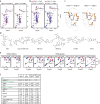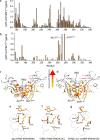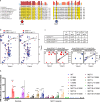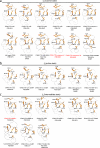Orthosteric STING inhibition elucidates molecular correction of SAVI STING
- PMID: 40595544
- PMCID: PMC12217682
- DOI: 10.1038/s41467-025-60632-5
Orthosteric STING inhibition elucidates molecular correction of SAVI STING
Abstract
While the progression of STING activators into the clinic has been successful, the discovery and clinical progression of STING inhibitors remain elusive. Questions persist about the molecular properties needed to distinguish between a STING activator and inhibitor, particularly within SAVI disease, a monogenic autoinflammatory disease that renders STING constitutively active, and how different conformations correlate to function. In this work, we use an orthosteric STING activator and inhibitor from the same chemical series to discover that STING M271 is a critical residue for molecular activation that can be leveraged as a unique molecular signature for pharmacological or genetically driven activation and inhibition. Furthermore, we demonstrate how the therapeutic requirements of a molecular corrector of SAVI STING differs from an orthosteric STING inhibitor, and why this is important for the SAVI disease population.
© 2025. This is a U.S. Government work and not under copyright protection in the US; foreign copyright protection may apply.
Conflict of interest statement
Competing interests: The authors declare no competing interests. Requests for materials should be addressed to Tao Xie.
Figures






Similar articles
-
Assessing the comparative effects of interventions in COPD: a tutorial on network meta-analysis for clinicians.Respir Res. 2024 Dec 21;25(1):438. doi: 10.1186/s12931-024-03056-x. Respir Res. 2024. PMID: 39709425 Free PMC article. Review.
-
The health economics of insulin therapy: How do we address the rising demands, costs, inequalities and barriers to achieving optimal outcomes.Diabetes Obes Metab. 2025 Jul;27 Suppl 5(Suppl 5):24-35. doi: 10.1111/dom.16488. Epub 2025 Jun 4. Diabetes Obes Metab. 2025. PMID: 40464081 Free PMC article.
-
A systematic review of the clinical effectiveness and cost-effectiveness of Pharmalgen® for the treatment of bee and wasp venom allergy.Health Technol Assess. 2012;16(12):III-IV, 1-110. doi: 10.3310/hta16120. Health Technol Assess. 2012. PMID: 22409877 Free PMC article.
-
Eliciting adverse effects data from participants in clinical trials.Cochrane Database Syst Rev. 2018 Jan 16;1(1):MR000039. doi: 10.1002/14651858.MR000039.pub2. Cochrane Database Syst Rev. 2018. PMID: 29372930 Free PMC article.
-
How to Implement Digital Clinical Consultations in UK Maternity Care: the ARM@DA Realist Review.Health Soc Care Deliv Res. 2025 May;13(22):1-77. doi: 10.3310/WQFV7425. Health Soc Care Deliv Res. 2025. PMID: 40417997 Review.
References
-
- Fosbenner, D. et al. Modulators of stimulator of interferon genes (STING). Patent No. WO2019069270A1 (World Intellectual Property Organization, 2019).
-
- Ramanjulu, J. M. et al. Design of amidobenzimidazole STING receptor agonists with systemic activity. Nature564, 439–443 (2018). - PubMed
MeSH terms
Substances
LinkOut - more resources
Full Text Sources
Research Materials

